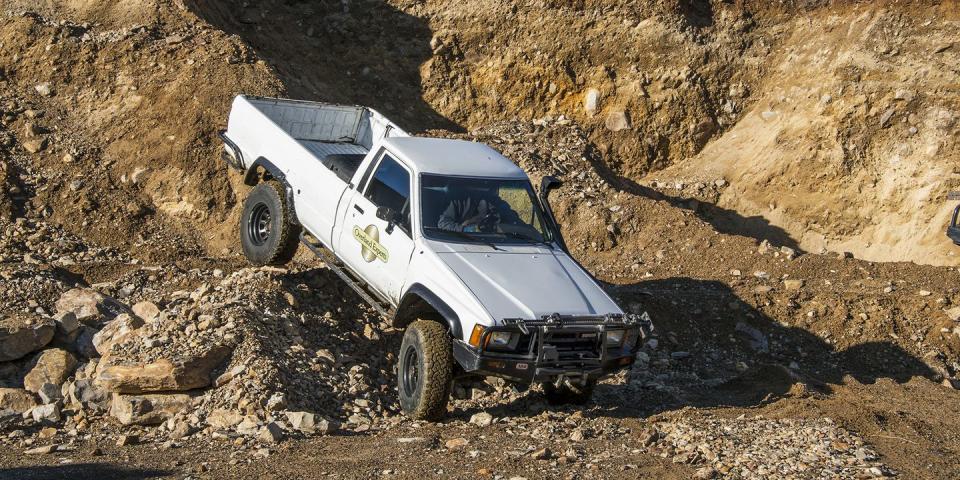Driver's Ed: Danger Zone

You’re in an unfamiliar country. A crowd of locals is gathering around you, and half of them look drunk. You need to drive your vehicle, maybe a convoy, out safely. And now the car won’t start.
Sounds like a scene from a Jason Bourne movie. At Overland Experts, based in East Haddam, Connecticut, it’s part of the curriculum. The idea is to simulate conditions that students-mainly soldiers, contractors, and non-government-organization workers-encounter in far-flung places.
“It’s tiresome, and we drill and drill,” says founder Bruce Elfström, who first got behind the wheel at age nine and was driving Range Rovers through war-torn Beirut as a teen in the 1980s. “Then I get a Christmas card from a guy saying, ‘Thank God you put us through that!’ because it saved his life in some awful corner of the globe.”
Although the training scenarios are hyperspecific, the basic lessons benefit anyone. “These skills have taught me how to drive a shitbox Civic on roads most Americans wouldn’t take a Jeep Rubicon on,” Elfström says.
Every skill hinges on situational awareness. “It starts with don’t get stuck,” Elfström says. “Because [if you do], you’re at the whim of somebody else, or you’re going to get hurt getting unstuck.” Always have a plan, he adds. “And then what if plan A fails, and plan B fails?”
With that in mind, some tips to stay safe, no matter if you’re extracting hostages in Tripoli or hopelessly lost on vacation:
ASSESS WHAT YOU HAVE: Whether driving your own car, renting a vehicle, or hiring a driver, don’t just pile in and head for the hills. “The only way you can have a plan is if you know the capabilities of that vehicle,” Elfström says. “You need to understand everything it can and cannot do, long before you drive it.” That includes what’s onboard. “Did you check what tools you have? Do you have a first-aid kit? What kind of jack is in the vehicle? Does it even have a full-size spare tire? Does the lug wrench fit the bolts on the wheels?”
Also consider the optics of your vehicle. Nothing says “not from here” like an ostentatious ride. Overland Experts teaches in diesel Toyota Hilux pickups-not sold in the United States but cleared for import by the U.S. Department of Defense-because they’re similar to what soldiers seek overseas. “Our special-forces guys don’t want to be seen in a Humvee,” Elfström says. “They want to blend in. The second they land, they pay cash for a Hilux, so they look like everybody else.”
TAKE IT SLOW: One way instruction at Overland differs from action movies is the emphasis on going slow, especially off-road. “Yes, you can gun it. But what happens to the next vehicle in your posse now that you’ve torn that line to pieces?” asks Erik Eisensmith, director of training at the school.
The take-it-slow approach is also about understanding how your car makes and loses traction. Most differentials, even limited-slip designs, initially send torque to the wheel with the least resistance, which can result in wheelspin. Avoid that by applying just enough throttle to preserve momentum, no more. Even high-tech SUVs are bound to physics: Mindlessly speeding over rough terrain might overheat the brakes by engaging stability control or hill-descent control too often. “You’re adding heat and stress and torque,” says Eisensmith.
AIR DOWN: In rugged terrain, tire pressure is the biggest ace any driver has, says Eisensmith. Lowering the pressure makes the contact patch longer and wider. “It literally pours over the ground, like a tank tread,” he says. “And you get more flotation in powdery snow or sand.” The softer the terrain, the lower you can go. “We’ve had Land Rover Discoveries at six psi, and in the snow, we could go anywhere.” Just remember, you’re trading away cornering capability and high-speed stability.
HIRE A FIXER: In some countries, it’s better to leave the driving to a local who knows the lay of the land, especially in places where bribes ensure safe passage. “You want someone who can read a situation, and your best tool is grading them on that ability, before you hire them,” Elfström says. You can tell a lot about a “fixer” by what they’re driving and how well they know it. Word-of-mouth recommendations from trusted sources are best. “No matter how glowing the reference, ask about your potential guide’s greatest weakness,” Elfström adds. “Because remember, whatever they don’t know, you’d better know.”
You Might Also Like

 Yahoo Autos
Yahoo Autos 